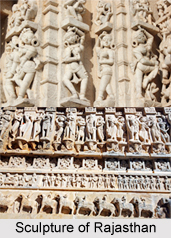 Sculpture of Rajasthan is replete with the lineages of local art trends and stylistic memorandums. It has the strange animosity towards stone and wooden sculptures. As far as the religious sculptures are concerned the theme of religiosity is a recurring one. The land of Meerabai and Bhakti saints Rajasthan presents some of the most exquisite stone figures of the lord. Besides these there are several stone and wooden sculptures that are available throughout Rajasthan. The expertise of the artists can truly surprise any tourist.
Sculpture of Rajasthan is replete with the lineages of local art trends and stylistic memorandums. It has the strange animosity towards stone and wooden sculptures. As far as the religious sculptures are concerned the theme of religiosity is a recurring one. The land of Meerabai and Bhakti saints Rajasthan presents some of the most exquisite stone figures of the lord. Besides these there are several stone and wooden sculptures that are available throughout Rajasthan. The expertise of the artists can truly surprise any tourist.
The red sandstone of Karauli and Dholpur was used to build Mughal forts and palaces at Agra, Delhi and Fatehpur Sikri. Other than these the forts and the stone monuments within Rajasthan are also etched out of stone. The stone palaces and monuments of Jaipur, Jodhpur, Bundi, Bikaner, Bharatpur, Chittorgarh, Udaipur and other smaller places and unique havelis of Jaisalmer are few examples of the rich sculptural art of Rajasthan. The remarkable features of these stone monuments are their columns, balconies, arches, domes, jharokhas, cupolas and the courtyards.
However one of the outstanding stone sculptures in Rajasthan is the Dilwara Temple, Mount Abu. This is a Jain temple and is made out of pristine white marble with the particularities pertained to the Jainism. If Agra is synonymous with Taj Mahal then the Dilwara Temple is closely associated with Rajasthan. What was once a religious iconography today it has developed as into a fine art. Jaipur is the biggest centre for creating marble images. Stone sculpture in Rajasthan can also be seen in Makrana, Jodhpur, Jaisalmer and Udaipur.
A beautiful murti of Sri Garuda is found at the Chittogarh Fort complex, which houses the Kumbha Shyam and Meera temples. Kumbha Shyam temple, built sometime in antiquity, was significantly renovated by the Rana Kumbha, in 1448 AD. The temple was originally dedicated to Lord Varaha. In the front of the temple is this excellent murti of Garuda, who is positioned in front of the temple. Garuda is shown in his half-man, half-bird form with relatively small wings.
Sas-Bahu Temple is known for its exquisite stone carvings, which are related to incidents of the Ramayana. Jagdish temple in Rajasthan is also known for its carved sculptures. Osian temple is also known for its carvings. Several Jain temples in Rajasthan have intricate sculptures.



















